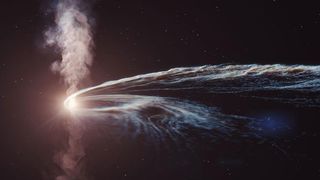Black hole discovered after ripping a star to pieces
The event could help astronomers figure out how supermassive black holes are born

Astronomers have discovered a black hole as it spaghettified a hapless star.
The intermediate-size black hole, located 850 million light-years from Earth in the galaxy SDSS J152120.07+140410.5, snared and shredded the star after it wandered too close, sending out a powerful beam of light that astronomers used to locate it.
Researchers spotted the flare, designated AT 2020neh, using the Young Supernova Experiment — a three-year survey of the sky using Hawaii-based telescopes that detects brief flashes from cosmic events such as supernova explosions. The researchers described the discovery Nov. 10 in the journal Nature Astronomy.
Related: Closest black hole to Earth discovered lurking in our 'cosmic backyard'
"The fact that we were able to capture this midsize black hole whilst it devoured a star offered us a remarkable opportunity to detect what otherwise would have been hidden from us," first author Charlotte Angus, an astrophysicist at the University of Copenhagen, said in a statement.
"What is more, we can use the properties of the flare itself to better understand this elusive group of middle-weight black holes, which could account for the majority of black holes in the centers of galaxies."
Black holes are messy eaters. When a black hole consumes a star, it produces a phenomenon called a tidal disruption event (TDE), which occurs when the powerful forces from the black hole's gravity act upon the helpless star.
Sign up for the Live Science daily newsletter now
Get the world’s most fascinating discoveries delivered straight to your inbox.
After being captured by a black hole’s gravity, a star will get reeled ever closer to the gluttonous giant’s maw before being stripped and stretched layer by layer as it falls inside. This process transforms the star into a long, noodle-like string of hot plasma that tightly winds around the black hole like spaghetti around a fork. The process causes the plasma to accelerate, spinning out into an enormous jet of energy and matter that produces a distinctive bright flash. Astronomers can then detect this flash using optical, X-ray and radio-wave telescopes.
The newly spotted black hole is rare because it is intermediate-size, falling within a category of black holes with masses anywhere between 100 to 10,000 times that of our sun. Scientists believe that these middleweight singularities gorge on gas, dust, stars and even other black holes to eventually transform into supermassive black holes. Supermassive black holes, which are often many millions or even billions times more massive than the sun, act as anchors for long trains of matter that swirl in orbit around them, but whether they actually come from intermediate black holes remains to be confirmed.
One theory suggests that the early universe teemed with dwarf galaxies that grew from intermediate black holes, and that these eventually merged into the larger galaxies and black holes we see today.
To see if this theory is viable, astrophysicists need to pin down just how many middleweight black holes exist.
“If we can understand the population of intermediate-mass black holes out there — how many there are and where they are located — we can help determine if our theories of supermassive black hole formation are correct,” coauthor Enrico Ramirez-Ruiz, a professor of astronomy and astrophysics at the University of California Santa Cruz, said in the statement.

Ben Turner is a U.K. based staff writer at Live Science. He covers physics and astronomy, among other topics like tech and climate change. He graduated from University College London with a degree in particle physics before training as a journalist. When he's not writing, Ben enjoys reading literature, playing the guitar and embarrassing himself with chess.
